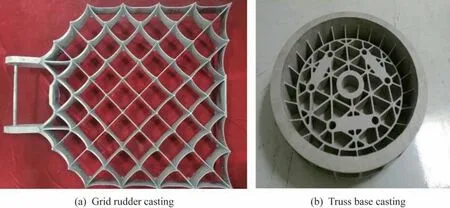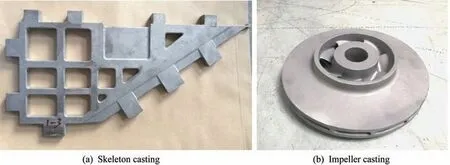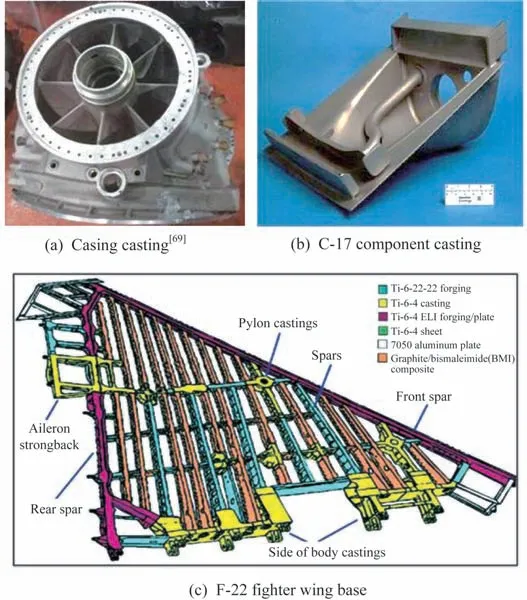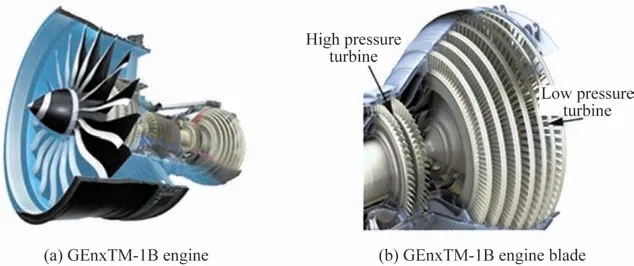Development and Application of Ti-based Alloy Casting Technologies in the Field of Aerospace
HOU Zhengquan,LI Baohui,FENG Gangwen,WU Jingxi,FAN Lipeng,GUO Yingfei,CHEN Yuyong,CHEN Bin,ZHANG Xuliang
(1.Shanghai Spaceflight Precision Machinery Institute,Shanghai 201600,China;2.School of Materials Science and Engineering,Harbin Institute of Technology,Harbin 150001,Heilongjiang,China)
Abstract:Ti-based alloys have been widely applied in the aerospace field,owing to their outstanding performance.Precision casting can be used to make integrated near-net-shape components with complex thin-walled structures,which will further promote the engineering application of Ti-based alloys.In this paper,the research progress of Tibased alloys,e.g.,high-temperature Ti-based alloys,high-strength Ti-based alloys,TiAl-based alloys,Ti-based matrix composites,and their precision casting technologies are reviewed.In addition,the development directions of Tibased alloys are presented based on the application status of Ti-based alloys in the aerospace field.
Key words:high-performance Ti-based alloy;TiAl-based alloy;Ti-based matrix composite;precision casting;aerospace
0 Introduction
Owing to the characteristics such as low densi‑ty,high specific strength,low thermal expansion co‑efficient,high elastic modulus,high corrosion resis‑tance,and high temperature resistance,Ti-based al‑loys have been widely applied in high-end manufac‑turing fields such as aerospace,ships,biomedicine,and new energy vehicles.However,with the con‑tinuous improvement of industrial manufacturing ca‑pacity,the aerospace equipment continues to develop towards the direction of high-speed and longdistance,and the existing conventional Ti-based al‑loys and their precision castings are more and more difficult to meet the needs of the aerospace field.The demands for integrated,complex,thin-walled,light‑weight,and high-performance Ti-based alloy cast‑ings are becoming increasingly urgent.Therefore,high-performance Ti-based alloys,TiAl-based alloys,Ti-based matrix composites,and their near-net-shape forming technologies have become the research hotspots of materials and engineering.In this paper,the research progress of Ti-based alloys and their precision casting technologies is reviewed,and the development trend of new Ti-based alloys and their precision casting techniques is pointed out.
1 High‑performance Ti‑based alloys
According to the various phase compositions,Ti-based alloys can be divided into α-type,near αtype alloys,(α+β)-type alloys,near β-type alloys,and β-type alloys.According to the service status,Ti-based alloys can be divided into low-temperature Ti-based alloys,high-temperature Ti-based alloys,high-strength Ti-based alloys,medium-temperature high-strength Ti-based alloys,burn-resistant Tibased alloys,and corrosion-resistant Ti-based alloys.According to the material structure,Ti-based alloys can be divided into Ti-based alloys,TiAl-based al‑loys,and Ti-based base composites.In recent years,the new developed Ti-based alloys are mainly con‑centrated in high-temperature Ti-based alloys,highstrength Ti-based alloys,TiAl-based alloys,and Tibased matrix composites.
1.1 High-temperature Ti-based alloys
With the rapid development of high-end aerospace equipment in terms of high-speed,longdistance,and high-temperature,Ti-based alloys have become one of the research hotspots.Many countries in the world have carried out a lot of research on high-temperature Ti-based alloys and established their own high-temperature Ti-based alloy systems.
At present,typical high-temperature Ti-based alloys mainly include Ti-1100(US),IMI843(UK),BT36(Russia),Ti60 and Ti600(China),etc.,the first three of which have been applied as compressor disks and blades of gas turbines in advanced jet engines.However,the highest service temperature of the high-temperature Ti-based alloys is still limited to 600 °C,as shown in Tab.1.

Tab.1 Properties of high-temperature Ti-based alloys at 600 ºC
The research shows that the surface temperature of the aircraft with a Mach number of 6 reaches 650 °C-750 °C.It is of great significance to break through the“thermal barrier”temperature(600 °C)and further develop new high-temperature Ti-based alloys.
At present,researchers have developed a series of short-term high-temperature Ti-based alloys used at 650 °C-700 °C.Based on the IMI834 Ti-based al‑loy,Japanese Kobe Steel Companyadded 1.0%Ta element to replace Nb,which significantly improved the oxidation resistance of the alloy at 650 °C.Using rapid solidified powder metallurgy and β heat treatment,General Electric Companyde‑veloped a new high-temperature Ti-based alloy with high-strength and oxidation resistance,which could be used at 650 °C,and indicated that the addition of Hf and Ta could significantly increase the high tem‑perature tensile strength,creep strength,and oxida‑tion resistance of the alloy.Replacing Zr with Hf,Korean Institute of Materials Sciencesuccessfully developed the Ti-6.5Al-4Hf-3Sn-0.4Mo-0.4Si-0.2Nb-0.1B alloy,which could be used at 650 °C,with the high tensile strength up to 667 MPa.Institute of Metal Research Chinese Academy of Sciencessuc‑cessfully obtained a Ti-based alloy with the tensile strength of 743 MPa at 650 °C by adding 2.0% Ta to the Ti-5.9Al-4Sn-3.5Zr-0.8W-0.4Si-0.3Mo-0.3Nb-0.06C alloy.Adding a certain amount of W and Nb elements and increasing the Mo content,Baoji Tita‑nium Industry Co.,Ltd.developed the Ti-6.5Al-3Sn-3Zr-3Mo-0.2Si-3Nb-1W alloy suitable for 650 °C-700 °C,with the tensile strength up to 445 MPa at 700 °C.Increasing the content of Zr,Harbin Institute of Technologydeveloped the Ti-6Al-3Sn-10Zr-0.8Mo-1Nb-1W-0.3Si alloy suitable for 650 °C-700 °C,the tensile strength of which could reach 640 MPa at 650 °C and 493 MPa at 700 °C.Adding rare earth elements(RE)into the Ti-Al-Sn-Zr-Mo-Si alloy,Shanghai Spaceflight Precision Ma‑chinery Institute developed a short-term high-tem‑perature Ti-based alloy with the tensile strength up to 590 MPa at 700 °C and successfully produced the cylindrical castings.The properties of typical high-temperature Ti-based alloys above 600 °C are shown in Tab.2.

Tab.2 Properties of typical high-temperature Ti-based alloys above 600 ºC
Two of the most important properties of hightemperature Ti-based alloys in service are strength and oxidation resistance at high temperature.The former determines the bearing capacity while the latter determines the bearing time under high temperature conditions.At present,material workers mainly improve the high temperature strength by adding α stabilizing element,e.g.,Al,Sn,and Zr,and high temperature element,e.g.,W and Mo.Adding α stabilizing element can increase the content of α-phase,which is effective to improve the strength of Ti-based alloys.Material workers mainly improve the oxidation resistance by adding elements such as W,Nb,Ta,and Si,which are effective to prevent the diffusion of O and reduce the solid solubility of O in Ti-based alloys.Besides,surface modification and surface coating are also commonly used to improve the oxidation resistance of Ti-based alloys,e.g.,plasma spraying,ion implantation,and heat resistant coating spraying.
1.2 High-strength Ti-based alloys
High-strength Ti-based alloys are mainly divid‑ed into(α+β)-type alloys,near β-type alloys,and βtype alloys.At room temperature,their tensile strength is greater than 1 100 MPa.Owing to the great processability and mechanical properties,wrought high-strength β-type Ti-based alloys have been widely used in the aerospace field.
American Crucible Steal Companydeveloped the first commercial β-type Ti-based alloy B-120VCA(Ti-13V-11Cr-3Al),and applied it to the SR-71 reconnaissance aircraft.The strength of B-120VCA reaches 1 240 MPa,and the elongation is 2%.However,the production cost of B-120VCA is high,which strictly limits its promotion and application.The β -C alloy(Ti-3Al-8V-6Cr-4Mo-4Zr)developed by RMI Company has the tensile strength of 1 400 MPa,and has high plasticity after double aging heat treatment.Timer Company developed Ti-1023 alloy(Ti-10V-2Fe-3Al)and β-21S alloy(Ti-15Mo-2.6Nb-3Al-0.2Si).After heat treatment,the strength of Ti-1023 alloy reaches 1 300 MPa,the strength of β -21S alloy reaches 1 450 MPa,and the cold deformation degree exceeds 70%.The strength of BT22 alloy(Ti-5Al-5V-5Mo-1Cr-1Fe)developed by Soviet Union maintains at 1 100 MPa-1 300 MPa after aging heat treatment.In recent years,Airbus developed Ti-55531 alloy(Ti-5Al-5V-5Mo-3Cr-1Zr)on the basis of BT22.The strength of Ti-55531 alloy reaches 1 500 MPa after heat treatment,but the plasticity is only 0.3%.American Boeing Company and Russian VSMPO Company developed Ti-5553 alloy(Ti-5Al-5V-5Mo-3Cr).The yield strength of Ti-5553 alloy exceeds 1 500 MPa after solution aging heat treatment.
Before 1990s,research on high-strength Tibased alloys in China mainly focused on imitating mature foreign Ti-based alloys.TB2 Ti-based alloy(Ti-5Mo-5V-8Cr-3Al)was first successfully prepared by General Research Institute for Nonfer‑rous Metals in China,with the yield strength of 1 100 MPa-1 200 MPa and the elongation of 12%.Subsequently,TB3 and TB4 were developed,and TB5(imitation Ti-15-3),TB6(imitation Ti-1023)as well as TB8(imitation β-21S)were successfully imitated,which laid a theoretical foundation for the development of new high-strength Ti-based alloys in China.In the 21st century,General Research Insti‑tute for Nonferrous Metals developed the highstrength and high-toughness TB10 alloy(Ti-5Mo-5V-2Cr-3Al).Northwest Institute for Non-Fer‑rous Metal Research developed Ti-B19(Ti-3Al-5Mo-5V-4Cr-2Zr),TC21,Ti-B20(Ti-3Al-5Mo-5V-4Cr-2Zr),and Ti-1300 alloys.The strength of Ti-based alloys in China reaches 1 300 MPa.
At present,the improvement of properties of high-strength Ti-based alloys mainly depends on the adjustment of alloy composition.Al and a large amount of Zr can be used to improve the solid solution strengthening effect,while a small amount of Zr can be used to realize the fine grain strengthening effect.Mo can be used to strengthen the β-phase and im‑prove the hardenability,so that the strengthening ef‑fect of heat treatment can be enhanced.As an isomor‑phic β stabilize element,V can be used to refine the grains and improve the strength of Ti-based alloys.Although great achievements have been made in the development of new high-strength Ti-based alloys,there is still a great disparity with the world advanced level.The mechanical properties of typical highstrength Ti-based alloys are shown in Tab.3.

Tab.3 Typical high-strength Ti-based alloys and their mechanical properties
1.3 TiAl-based alloys
Owing the characteristics of low density,high specific strength and specific stiffness,and excellent high-temperature oxidation resistance and creep resis‑tance,TiAl-based alloys are regarded as an impor‑tant candidate material to replace high-temperature al‑loys in the temperature range from 700°C to 950°C.However,the plasticity of TiAl-based alloys at room temperature is poor,which seriously hinders their in‑dustrial application.
The typical representative of the first-generation TiAl-based alloy is Ti-48-1V-0.3C developed by American Air Force Materials Laboratory and P&W Company,but the research was terminated in the labo‑ratory stage.The typical representative of the secondgeneration TiAl-based alloy is the as-cast Ti-48Al-2Cr-2Nb alloy jointly developed by American Air Force and GE Company.Since the 21st century,the third and fourth generations of TiAl-based alloys en‑tered the research and development stage.Among the third generation TiAl-based alloys,Professor KIM proposed a new β-γ TiAl-based alloy with uniform and fine as-cast structure,good high-temperature plastic forming ability,and good machining ability,which attracted widespread attention from scholars all over the world.University of Science and Technology Beijing developed high-Nb TiAl-based alloys to improve the creep resistance and oxidation resistance of TiAl-based alloys.The maximum service temperature of the high-Nb TiAl-based al‑loys exceeds 800 °C.Harbin Institute of Technology developed Ti-43Al-9V alloys by adding a large num‑ber of β stabilizing element V,and proposed the dis‑persion technology in TiAl-based alloys,which sig‑nificantly refined the grain size and improved the comprehensive mechanical properties.Compared with Ti4822 alloy,the tensile strength of Ti-43Al-9V increases by 65% at room temperature and 52%at high temperature,the elongation increases by two times at both room temperature and high tempera‑ture,and the creep life increases by three times.Nanjing University of Technology prepared single crystal samples with the semi-solid rapid cooling di‑rectional solidification technology.The plasticity of the single crystal samples at room temperature can reach 6.9%,and the tensile strength can reach 987 MPa.
Single crystal TiAl-based alloys also can be used to solve the problem of temperature plasticity and oxidation resistance,but the difficulty of prepara‑tion limits their promotion and application.The me‑chanical properties of typical TiAl-based alloys are shown in Tab.4.

Tab.4 Typical single crystal TiAl-based alloys and their mechanical properties
1.4 Ti-based matrix composites
Owing to the characteristics of high temperature strength,good creep resistance,high specific stiff‑ness,and good impact resistance,Ti-based matrix composites are composed of Ti-based alloys(as ma‑trix)and ceramic reinforcing phases(as reinforce‑ment).Compared with conventional Ti-based al‑loys,the service temperature of Ti-based matrix composites can be increased by 100 °C-200 °C,and the strength can be increased by more than 100 MPa.The melting and casting process of Ti-based matrix composites has been widely used because of their simplicity,low cost,and easiness of manufacturing complex structural parts.Shanghai Jiao Tong Univer‑sity successfully prepared discontinuous particle rein‑forced Ti-based matrix composites with different rein‑forcement systems.On this basis,the material design idea of multi-element and multi-scale enhancement was proposed.The mechanical proper‑ties of composite materials are controlled by design‑ing and adjusting the combination and ratio of differ‑ent matrices and reinforcements.Up to now,Shang‑hai Jiao Tong University has developed binary sys‑tems,e.g.,(TiB+TiC)and(TiB+LaO),and multivariate multi-scale hybrid reinforcement systems,e.g.,(TiB+TiC+LaO)and(TiB+TiC+YO).Shanghai Spaceflight Precision Ma‑chinery Institute and Shanghai Jiao Tong University jointly developed 2% TIB and 0.8% LaOparticle enhanced IMI834 Ti-based composites after preci‑sion casting,hot isostatic pressing,and heat treat‑ment.The tensile strength of the composites is more than 1 100 MPa at room temperature and more than 600 MPa at 700 °C.Harbin Institute of Technology designed and prepared a series of TiB/Ti compos‑ites with quasi-continuous network distribution of TiB,which further improved the reinforcement effect of Ti-based composites,and developed TC4-based composites for 500 °C -600 °C.In order to achieve lightweight,heat-resistant,and processable Ti-based composites for the aerospace field,TA15-based composites for 500 °C-700 °C and Ti60-based composites for 600 °C-800 °C were also devel‑oped.The mechanical properties of typical Ti-based composites are shown in Tab.5.

Tab.5 Typical Ti-based composites and their mechanical properties
2 Precision forming of Ti‑based alloys
2.1 Ti-based alloy melting
With the high chemical activity at high tempera‑ture,molten Ti-based alloys can chemically react with almost all refractory materials,and are particu‑larly sensitive to the interstitial elements such as H,O,and N.Therefore,the melting of Ti-based alloys must be in a vacuum or inert atmosphere.At pres‑ent,the melting of Ti-based alloys is mainly divided into vacuum consumable remelting and vacuum nonconsumable melting.Vacuum consumable remelting mainly includes vacuum consumable arc remelting(VAR)and electroslag remelting(ESR).Vacuum non-consumable melting mainly includes electron beam cold-hearth melting(EBCHM),vacuum nonconsumable arc melting,and cold crucible inductive melting.The cold-hearth melting can be further di‑vided into electron beam hearth melting and plasma beam cold-hearth melting according to the heat source.VAR and EBCHM have been widely applied in industrial production of Ti-based alloy ingots.
Since the middle of the 20th century,the indus‑trial production of Ti-based alloy ingots is mainly based on VAR.The advantages of VAR are fast melting speed,high automation degree,and simple operation,while the disadvantage is that it is hard to fundamentally eliminate the casting defects of low-density and high-density inclusions,even if the alloys are melted three times.Therefore,EB‑CHM was introduced in 1980s.EBCHM is an ad‑vanced melting technology for producing clean metal and effectively eliminating all kinds of low-density and high-density inclusions.
2.2 Ti-based alloy precision casting
Ti-based alloy precision casting mainly includes machined graphite casting and investment casting.Owing to the reactions of Ti-based alloys and the mold materials,defects,e.g.,pores and inclusions,inevitably occur in Ti-based alloy castings,which will seriously affect the quality of the castings.Moreover,it is difficult to keep the molten Ti-based alloy fluid in an ideal overheating state,which makes the filling ability of Ti-based alloys greatly reduce and the difficulty of manufacturing castings in‑crease.In view of the above problems,researchers have systematically studied the refractory coatings of graphite machining,molten shell surface materials,and preparation process,and improved the liquid fill‑ing ability to ensure the quality of Ti-based alloy pre‑cision castings.
2.2.1 Machining graphite mold casting
Owing to the advantages of strong technical flex‑ibility,short development cycle,high mechanical properties,and dimensional accuracy of cast‑ings,graphite machining mold casting takes high-purity artificial graphite blocks as the modeling material.It is suitable for the large-scale development and production of Ti-based alloy castings,and can help the alloys achieve sequential solidification.How‑ever,because of the strong chilling ability of the graphite machining mold,casting defects,e.g.,cold shut,flow mark,and crack,inevitably exist on the casting surface.
To solve such problems,researchers have devel‑oped a series of new graphite machining mold casting processes,e.g.,special coated graphite mold technol‑ogy and graphite mold ceramic core composite tech‑nology.Shanghai Spaceflight Precision Machinery Institute has produced large-scale grid rudder castings(the contour size is 1 300 mm×1 000 mm×240 mm,and the minimum thickness is 4 mm)with the spe‑cial coating graphite technology(see Fig.1(a)),and realized the integrated forming of large thinwalled castings.Aerospace Hiwing(Harbin)Titani‑um Industry Co.,Ltd.has prepared a1 047 mm×158 mm truss base casting with the graphite machin‑ing mold(see Fig.1(b))(the minimum thickness is 3 mm).With the rapid development of computer auxiliary process and machining technology,the manufacturing cycle of graphite machining mold will be further shortened,and the application of graphite machining mold in Ti-based alloy precision casting will continue to expand.

Fig.1 Typical Ti-based alloy castings prepared with graphite machining mold
2.2.2 Investment casting
In the investment casting process,the surface refractory contacts with the molten Ti-based alloy di‑rectly.This requires the refractory to have sufficient strength,fire resistance,thermal expansion,and wettability.To weaken the interfacial reaction as much as possible,the chemical stability between the refractory and the molten Ti-based alloy should be high enough.Investment casting shell mainly in‑cludes graphite shell,tungsten surface ceramic shell,and oxide ceramic shell.Among them,oxide ceramic shell is the most widely used in the invest‑ment casting technology for new Ti-based alloys.At present,only ZrOpowder,YOpowder,and their optimized powder are used for industrial production,and the binders mainly include metal organic compound binders(e.g.,zirconium acetate and zirco‑nium glue)and colloidal oxide binders(e.g.,colloi‑dal ZrOand colloidal YO).In the early stage,in‑vestment casting in China was mainly used for smalland medium-sized Ti-based alloy castings(see Fig.2).

Fig.2 Ti-based alloy castings prepared with investment casting
At present,the size of Ti-based alloy castings prepared by investment casting has exceeded 1 000 mm,e.g.,the large complex thin-wall frame casting produced by Guizhou Anji Aviation Precision Casting Co.,Ltd.(the contour size is 1 450 mm×835 mm×772.2mm,and the minimum thickness is 2.5 mm),the aviation shell casting produced by Beijing Institute of Aeronautical Materials,and the aerospace skeleton castings produced by Shenyang Research Institute of Foundry Co.,Ltd.In recent years,with the improvement of the quality and economic requirements of new Ti-based alloy cast‑ings,investment casting has been continuously im‑proved,and a series of new technologies have been successfully developed,e.g.,the slurry in-situ aggre‑gation overall ceramic mold preparation technology,the SiC-based new shell preparation technology,the SiO-YOshell preparation technology,and the plas‑tic shell investment technology.
3 Applications of Ti‑ based alloys in the aerospace field
With the continuous development of high-perfor‑mance Ti-based alloys,the improvement of the hot isostatic pressing(HIP)technology and the growing maturity of near-net forming technologies such as pre‑cision casting and machining,cast Ti-based alloys have become one of the most widely used alloys in the aerospace field.Titanium is used instead of nickel and steel to achieve the lightweight components and equipment,and thus the speed and range of aero‑space vehicles are effectively increased.At present,Ti-based alloys have been widely used in the fuse‑lage,wing,landing gear,hatch,and engine of air‑craft as well as the shell,support,and engine of aero‑space craft.
Owing to the outstanding cost and process ad‑vantages,precision casting has become one of the fastest developing and the most widely used preci‑sion forming processes.At present,more than 98%of Ti-based alloy castings used in the aerospace field are made of precision casting.In the early 1970s,American PCC Company and German MTU Compa‑ny successfully produced800 mm RB199 engine in‑termediate gearbox with the oxidation ceramic shell technology.In the 1980s,American PCC Com‑pany successively produced1 300 mm CF680C2 engine intermediate gearbox and2 000 mm GE90 engine fan hub with the precision casting technolo‑gy.The C-17 military transport aircraft is equipped with precision thin-wall Ti-based alloy castings with a thickness of about 1.25 mm(see Fig.3(b)).In the early 21st century,the fuselage of the fourth-genera‑tion F-22 fighter aircraft in the United States was equipped with about 54 parts made of Ti-based alloy precision castings(see Fig.3(c)),and the entire adapter seat of the V-22 tilt rotor aircraft was made of Ti-based alloy precision castings.At present,the consumption proportion of Ti-based alloys in ad‑vanced foreign aero-engines has reached 25%-40%.Since the equipment development involves national military secrets,there is no report on the application of high-performance Ti-based alloy precision castings in the aerospace field.

Fig.3 Ti-based alloy precision castings abroad
Ti-based alloy precision casting technology de‑veloped late in China.However,its development speed is so rapid that the technology has reached the international advanced level under the unremitting efforts and continuous innovation of scientific re‑searchers.
At present,deformed high-performance Tibased alloys have been widely used in the aerospace field,and a variety of commercial airliners have successfully used Ti-based alloys in civil aviation.The proportion of Ti-based alloys used in the C919 large airliner developed in China independently has reached 9.3%,and each C919 air craft requires about 200 000 Ti-based alloy fasteners.The proportion of Ti-based alloys used in the new-generation aviation turbofan engine is expected to exceed 30%.In terms of military affairs,the proportion of Ti-based alloys used in the engine of new generation high-perfor‑mance fighter in China is expected to be 25% -30%.However,conventional ZTC4 and ZTA15 alloys are still the main Ti-based alloys used in the aerospace field(see Fig.4),and the engineering ap‑plication of high-performance cast Ti-based alloys is still rarely reported.

Fig.4 Domestic Ti-based alloy precision castings
In terms of TiAl-based alloys and Ti-based matrix composites,American GE Company used Ti-48Al-2Cr-2Nb alloy to replace Ni-based superalloys to manufacture the 6th and 7th stage low-pressure turbine blades of GENX engine(see Fig.5),and successfully tested them in Boeing 787 aircraft in 2006.It is the first time for TiAl-based alloys to be applied in the key structural parts of an aircraft engine.The use of TiAl-based alloys can reduce the weight of a single engine by about 200 pounds,the engine fuel consumption by 20%,the noise by 50%,and the NOgas emission by 80%.American GE Company and France Snecma Company adopted low-pressure turbine blades made of TiAl-based alloy castings in the leap series aeroengines to re‑place the CFM56 engine,and applied them on Boe‑ing 737 aircraft as well as Airbus A320neo air‑craft.Ti-43.5Al-4Nb-1Mo-0.1B(TNM)alloy low-pressure turbine blades and Ti-45Al-5Nb-0.2B-0.2C(TNB-V4)alloy high-pressure compressor blades prepared by Leistritz Company through the hot die forging process were successfully applied to the PW-1100G engine developed by MTU Compa‑ny.TiC reinforced Ti6A14V composites developed by Dynamet Technology Company have been used as missile tail and aircraft engine parts.The Tibased matrix composite landing gear support devel‑oped by Dutch Aircraft Landing Gear Development Company has been installed on the F16 Multirole fighter,which reduced the weight of the structur‑al components by 40%.Rolls-Royce tested a C/Ti composite fan system,and found that the weight of an aircraft was reduced by up to 1 500 pounds.Com‑pared with the first-generation Rida engine,the new engine will reduce fuel and COemissions by at least 20%.

Fig.5 Application of TiAl-based alloy precision castings abroad
In recent years,domestic researchers have car‑ried out a large number of systematic studies,and have achieved certain results,which significantly pro‑moted the engineering applications of TiAl-based al‑loys and Ti-based matrix composites.Institute of Met‑als Research Chinese Academy of Sciences has suc‑cessfully prepared TiAl-based alloy low-pressure tur‑bine blades with centrifugal precision casting.The components have completed 1 750 simulated flight cy‑cle evaluation tests on the Trent XWB engine of Brit‑ish RORO Company,including one overhaul cycle.
Compared with traditional superalloy castings,the weight of igniter elbow castings of the hyperson‑ic aircraft engine developed by Harbin Institute of Technology was reduced by 50%,with excellent performance in the ground ablation test.Shanghai Spaceflight Precision Machinery Institute prepared Ti-based matrix composite skeleton castings with complete shape by simulating the precision casting process of Ti-based matrix composites.The715 mm×69 mm casing pre diffuser casting(see Fig.6(a))jointly developed by Harbin Institute of Technology and Beijing Institute of Aeronautical Materials broke through the key technology of inte‑gral forming for large thin-wall complex TiAl-based alloy castings is the largest and most complex TiAlbased alloy castings in China,and has passed the static evaluation test of Shanghai Spaceflight Preci‑sion Machinery Institute.A high stability oxide ce‑ramic shell suitable for high-temperature Ti-based matrix composites was jointly developed by Shenyang Casting Research Institute and Harbin In‑stitute of Technology,and the skeleton casting of high-temperature Ti-based matrix composites was prepared(see Fig.6(b)).

Fig.6 Domestic TiAl-based alloy and Ti-based matrix composite precision castings
4 Conclusions
In this paper,the research and application of high-temperature Ti-based alloys,high-strength Tibased alloys,TiAl-based alloys,Ti-based matrix composites,and their castings in the aerospace field are reviewed.In recent years,great breakthroughs have been made in the research of new Ti-based al‑loys in China.The comprehensive properties of new Ti-based alloys have caught up with and surpassed foreign Ti-based alloys,and various Ti-based alloy castings have been prepared successfully.However,there is no systematic research on the microstruc‑ture,room temperature strength,high-temperature strength,creep property,and high-temperature oxi‑dation resistance of cast Ti-based alloys.The technol‑ogy maturity of new Ti-based alloy castings is still low,and new Ti-based alloy castings have not been widely applied in engineering.To promote the indus‑trial application of new high-performance cast Tibased alloys in the aerospace field,the subsequent re‑search should focus on the following aspects.
1)Combine with numerical simulation methods such as the first-principles method,design and devel‑op new high-performance Ti-based alloys,systemati‑cally research the performance,reasonably match the strength,plasticity,fatigue resistance,and high-tem‑perature oxidation resistance,and improve the com‑position uniformity of large-capacity Ti-based alloy melting.
2)Continue to research on the mold materials and mold preparation processes for Ti-based alloy precision castings,reduce the thickness and cracking tendency of the surface contamination layer of Tibased alloy castings,strengthen the application of nu‑merical simulation in Ti-based alloy precision cast‑ings,and realize precision casting of Ti-based alloys without machining allowance casting.
3)Promote the standardization and pattern spec‑tra of new high-performance cast Ti-based alloys,and provide theoretical basis and technical support for the material selection in aerospace vehicle design.
- 上海航天的其它文章
- Applications of Magnesium Alloys in Aerospace and Aviation
- Repair Welding of Casting Magnesium Alloys:A Review
- Research on Residual Stress Measurement of Magnesium Alloy Cabin Castings
- Microstructure and Hot Deformation Behavior of Mg-9Al-3Si-0.375Sr-0.78Y Alloy
- Effect of Semi-solid Isothermal Heat Treatment on Microstructure of VW63Z Alloy
- Study on the Deformation Behavior of Mg-Gd-Y-Zn-Mn Wrought Magnesium Alloys by Visco-plastic Self-consistent Modeling

